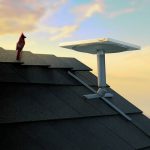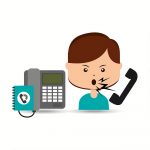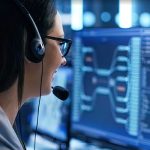Mobile Coverage in Worcestershire UK is 1000x Worse Than Ofcom Suggests UPDATE

The Worcestershire County Council (WCC) in England has revealed the results of a recent study they conducted with Streetwave, which harnessed local bin lorries to map the coverage and performance of 4G and 5G mobile (broadband) networks across the county. Overall, it claims to have found that mobile coverage is “over 1,000 times worse than Ofcom and mobile operator data suggests“.
Just to recap. Streetwave has spent the past two years or so harnessing refuse collection trucks to map mobile network coverage and speeds across various parts of the UK (e.g. here, here, here, here and here). In this setup, refuse trucks are installed with several off-the-shelf Smartphones using special software (pictured), which run continuous network tests – once every 20 metres in rural areas and 5m in urban areas – as the vehicles go around their routes.
The street-level data they collect is then used by local authorities to help identify areas that may require additional intervention in order to improve local mobile coverage and or network capacity. This is often much more accurate than the estimates of network coverage and performance put out by the operators themselves. In addition, members of the public have also been given access to some of this data via address-based coverage checkers and interactive maps.
Advertisement
The latest study was conducted as part of a much wider survey, which stretches across the River Severn Partnership Advanced Wireless Innovation Region (here). But today we’re specifically focusing upon the results for Worcestershire within that programme (see the new Worcestershire Map).
According to the WCC, the results are said to show that mobile network coverage in the county is “over 1,000 times worse than Ofcom and mobile operator data suggests“. Official Ofcom data claims that only 0.01% of Worcestershire postcodes lack access to a usable mobile signal. However, real-world measurements from the survey found that 10.03% of postcodes “have no usable signal – a striking discrepancy“, said the council.
Councillor Adam Kent, WCC Cabinet Member for Economy and Skills, said:
“The data speaks for itself. Worcestershire residents and businesses are facing unacceptable levels of mobile signal failure. Ofcom and the operator’s modelled data paints an overly optimistic picture that simply does not reflect the reality on the ground. This real-world data and evidence can now help drive meaningful change, and this research is a crucial first step toward holding providers and regulators to account.”
George Gibson, Co-founder of Streetwave, said:
“Our findings highlight the significant gap between modelled data and actual user experience. People deserve to know the truth about their mobile coverage, and this research gives us the evidence to push for real improvements. Accurate data is key to driving change and ensuring that everyone, especially those in rural areas, has reliable mobile connectivity.”
The council further claims that the switch-off of 3G networks has “worsened the situation“, particularly in rural areas where “3G provided better coverage over long distances“. Many older mobile devices have also become obsolete, forcing users to upgrade, but poor 4G and 5G signal strength “means even new devices struggle to connect reliably“.
The WCC also suggested that this is “having a major economic impact“, with the county “losing an estimated £226 million per year” due to lost productivity and communication failures. But we always advise taking such economic estimates with a big pinch of salt, as such things are notoriously difficult to model with any real accuracy.
Advertisement
The full extent of the problem, including much more data, was covered in a presentation yesterday, which can be watched below.
UPDATE 17th March 2025 @ 6:55am
We’ve had a comment from Ofcom.
An Ofcom spokesperson told ISPreview:
“Our current coverage data comes from mobile network operators’ predictions, which we recognise may not always match people’s real-world experience at a very local level. We are working hard to overhaul our mobile coverage checker, which we expect to relaunch later this year with new and improved data to better reflect what people can expect”.
Mark is a professional technology writer, IT consultant and computer engineer from Dorset (England), he also founded ISPreview in 1999 and enjoys analysing the latest telecoms and broadband developments. Find me on X (Twitter), Mastodon, Facebook, BlueSky, Threads.net and Linkedin.
« North Lanarkshire to Deliver Free Broadband to 36,575 Council Homes























































My question then is why isn’t this a national contract with Streetwave and why Ofcom relies on mobile provider theoretical estimates. The fact that Local Authorities are funding this type of activity clearly shows to me that Ofcom should be providing this.
https://app.streetwave.co/coverage-checker/60/map
In this case it clearly shows EE as the overall best and depending on where you visit which provider network would be suitable for dual SIM. I visit Wales a lot and it aligns with my experience.
For fixed mobile nothing substitutes for testing but for general mobile provider selection it would be very useful and perhaps give some providers the kick they need.
Where is that one place that I don’t need a mobile phone signal?
My home…due to WiFi Calling.
Whilst the data might suggest that there’s a big issue here, in reality it isn’t going to be as bad as those figures suggest.
Er? Mobile phones are made for mobile use, no good if you can’t get a signal outside your home.
I know a few people who live in Worcester or go into Worcester and some of them have said about mobile networks there and this is via different networks.
I have not been to Worcester for a few years, so I would not know myself.
Mobile networks are not great here in Herefordshire either, when I go into our city centre, if I go to the Old market shopping centre, white elephant thing, I lose signal in certain places.
Have you considered that not everyone has WiFi at home?
I know numerous people who don’t have WiFi and rely solely on their mobile phone, or one of the portable 4G routers for Internet.
Even if you do have WiFi, many of those solutions offer a 4G backup if the fixed line goes down, how can you expect that to work if you don’t have signal?
Does your phone automatically connect to WiFi when you enter a business? When you go to your friend’s house? No? Then it’s not a replacement for the mobile network signal.
This is no surprise to anyone who lives in a rural area. The official coverage maps are fantasies.
The situation is much better than it used to be due to WiFi calling indoors, but when out and about signal can be curtailed severely by topography or woodland.
Whilst it’s hardly news that a report has proven that OfCOM really is the office of comedy, it really does demonstrate how ineffective our communication regulator is (as are several others). Whether that’s due to ineptitude or lack of resources I’m not certain, but we all suffer because of it.
Well I agree. Self selecting fantasy island regulators require a good spring clean.
Take a lesson from NHS England before the grim reaper comes to you, ofcom .
Our parish in Devon carried out a less scientific survey but came to the same conclusion: signal coverage is grossly overestimated. Official coverage data indicates that the whole of the parish’s main village has “good” signal outside on all networks: over half of residents reported no signal at all.
For as long as network planning and upgrades rely on incorrect data, those of us in weaker than predicted signal areas are disadvantaged, particularly as some version of “everyone can use use a mobile phone” becomes the default assumption about everything from 2FA to the PSTN switchoff. If “everyone” supposedly has signal already, why bother upgrading the network or providing alternatives?
In our case, one operator – EE, who deserve credit – came out, measured the signal, confirmed the problem and actively sought to improve the coverage, which would not have happened without a localised survey.
As for WiFi calling indoors, it’s not a panacea. It still isn’t available on all devices or networks, and more importantly suffers the same problem as “Digital Voice”: no mains power, no service, often in the very areas that have the most frequent power interruptions.
The trouble is that people saying there’s no signal doesn’t necessarily mean there is no signal.
In rural areas that typically have a slightly older population it’s reasonable to surmise that handsets may also be less advanced.
Networks have a range of frequencies – some of which are only accessible on the most modern handsets.
Indeed, Richard. A friend of mine is always complaining about no signal with his old phone whereas I, stood right next to him, have a full signal on my iPhone 15. We are both on EE. The article says the survey uses a range of phones I would assume they’re taking the worst result. I wonder if the results would be significantly better if they took the best results – which is probably what the telcos are using.
O2 in the west side of Worcester (WR2)is awful. But none of the networks has really strong signals in this area but according to OFCOM they provide the best signals available.
Another example of self-reporting not working. Ofcom have collected billions in spectrum auction fees, they should be the ones doing this type of verification.
An interesting presentation. But I do think there is important detail and information missing from the presentation if not from the report. I spent several years working in mobile communications in radio design engineering but using collected data as part of the design process. The planning technicians I worked with would spend up to 50% of their time doing physical coverage testing – signal strength, uplink (device to ‘mast’) and downlink (‘mast’ to device) performance, especially when masts were freshly installed or moved.
Firstly Ofcom’s coverage requirement to a percentage of the UK population rather than land mass as most people assume; that is never made completely clear.
Secondly the ‘Streetwise’ people never commented on where on the vehicles the antenna’s were attached or were they relying on the devices own built in antenna. The data I made use of was with a mobile antenna at a height of 1.5mtrs, with a device antenna to be at 1.2mtrs. Also would the 4 devices be running all the time so there would be interference from the other devices in the ‘box’, especially without external antennas.
I’m not saying the work they do (did) was not invaluable but it does need better detail on how it is collected to ensure fairness.
Your point gets to the nitty gritty detail, rightly so.
Which leads us to the typical user, who now has a handheld 3/4g phone (maybe 5g if ambitious).
Not a bare antenna stuck up high and clear.
So even if the bin lorries phone was stuck in the guys pocket I’d contend the results more typical.
WiFi calling at home isn’t a lot of use when there’s a power failure. As one of the mitigations Ofcom and the telcos bang on about for the loss of resilience after POTS switch-off is….. the mobile network, then home mobile coverage IS important.
As for computer-predicted coverage models – it works both ways. The DCC insists I don’t have SMETS2 coverage. My meter and my half-hourly billing insists otherwise.
Poor signal areas confirmed, measures to improve signal = new masts, a good number of the general public don’t want mast near them, so on goes the problem of poor signals for the rest of the public.
> 3G provided better coverage over long distances
Did WCC provide any evidence to support this statement? I would expect 4G B20 (800 MHz) to provide better coverage over long distances compared with 3G.
Expect is one thing.
Measure and report report is quite another.
Very true, Stan, but we know that lower frequencies are better at penetrating obstacles than higher frequencies – it’s a well understood area of physics. In this case I’m using “expect” in the same way as e.g. I expect my phone to fall towards the ground due to gravity if I drop it.
Not just the sticks, 4 friends inside Alexandra Palace Saturday 15th. Ok it was an event, but between us 02, Voda and me on EE (piggy back), they had 0-1 bars, I had 1 bar. My point is one of the highest points in London inside and hopeless. Yes faffed with local WiFi. However no one is surprised at these tests confirming what we all know, the lies and BS fed to us. If we all believed we had superb mobile coverage, most of us that don’t need data speed would ditch the fixed line fibre, but we don’t, because we know the truth, mobile data is unstable. PS my POV in single low data usage household and retired.
I would state that Worcestershire isn’t the only area with poor mobile phone signal.
I suspect that the providers are not telling the truth about coverage and we believe their lies.
Can’t say I’m surprised really.
O2 was an absolute trainwreck in Worcester city centre if you didn’t happen to connect to the B20 femto in the O2 Store (eNB 509976 iirc). I think EE was struggling too.
Capacity improvements need to be investigated asap in that area as B1+20 is a joke.
It’s no surprise, I’m in rural Wales, there no broadband down the phone line, and mobile coverage, like all of the UK’s telecoms infrastructure, is shite. And no fibre on the horizon, just a decade of talk. No wonder we end up having to buy Internet access off a South African neo-fascist…
Seek help for that serious case of Trump derangement syndrome you have.
“1000x worse than expected”
I think you mean 10% worst than expected …
99.9% were expected to have coverage but the number is closer to 90%. That’s not 1000x worse.
The article states that mobile operators are claiming only 0.01% of postcodes cannot get a usable mobile signal, whereas WCC found that 10.03% of postcodes couldn’t get a usable mobile signal.
Try multiplying 0.01 by 1000 and see what you get.
Its like the “Handback” values for landline data comms.
According to BT Wholesale, the best speed I can get on FTTC, although adequate for my purposes at present, is 10-15Mbps lower than even the “Impacted” handback vales stated on their on-line page.
The Cannery Wharf dwelling regulator is in pink unicorn territory.
As regards mobile signals in rural areas, as a non-technical bod, you wonder why the local television and radio repeater masts and church steeples (Nice little earner) can’t be used as well as the stand alone masts, in a mesh mode, or why mobile signals can’t be modulated onto existing infrastructure, water pipes, electricity supply wires to feed these naturally occurring and man-made tropospheric projections. Come to that even a tethered balloon would do (And that might facilitate public service radio as well|).
The introduction of the new comms technology (Not so much of the “New” . . . its now 30 years old) has been so patchwork as to qualify for the use of the term “Cluster f*ck”.
Its holding the economy back . . . not the benefit claimants.